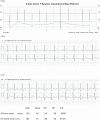ST segment depression in hypertensive patients: a comparison of exercise test versus Holter ECG
- PMID: 19183755
- PMCID: PMC2605337
- DOI: 10.2147/vhrm.s2419
ST segment depression in hypertensive patients: a comparison of exercise test versus Holter ECG
Erratum in
- Vasc Health Risk Manag. 2008;4(6):1481. Baulmann, Johannes [removed]; Mengden, Thomas [added]
Abstract
Introduction: This study compared ST segment depression (ST depression) during cycle ergometry (ergometry) versus simultaneous 24-hour ambulatory blood pressure measurement and electrocardiogram recording (24-h ABPM/ECG) during everyday life.
Methods: In a German multicenter study, ergometry and 24-h ABPM/ECG records of 239 hypertensive patients were retrospectively analyzed. ST depression was defined as an ST segment depression (1 mm limb or chest recordings V1 to V6) in an incremental cycle ergometry, or 1 mm in the 24-h ABPM/ECG recording under everyday conditions. Blood pressure parameters at the onset of ST depression in the context of the respective method were compared.
Results: 18 patients had ST depression only in ergometry (group B), 23 had ST depression only during 24-h ABPM/ECG monitoring (group C) and 28 patients had ST depression with both methods (group D). Group A had no ST depression with any method. In group D, at the onset of ST depression with 24-h ABPM/ECG investigation, all parameters except diastolic blood pressure were significantly lower compared with the corresponding parameters at the onset of ST depression with ergometry (systolic blood pressure: 148 +/- 19 vers 188 +/- 35 mmHg, p < 0.001; heart rate: 93 +/- 12 vs 120 +/- 21 beat/min, p < 0.0001; double product: 13,714 +/- 2315 vs 22,992 +/- 3,985 mmHg/min), p < 0.0001).
Conclusion: ST depressions during everyday life detected by 24-h ABPM/ECG are characterized by a substantially lower triggering threshold for blood pressure level parameters compared with ergometry. The two methods detecting ischemia do not replace but complement each other.
Keywords: ST segment depression; arterial hypertension; blood pressure measurement; combined 24-h ABPM/ECG.
Figures

References
-
- Aronow WS, Ahn C, Mercando AD, et al. Prevalence of and association between silent myocardial ischemia and coronary events in older men and women with and without cardiovascular disease. J Am Geriatr Soc. 2002;50:1075–8. - PubMed
-
- Asmar R, Benetos A, Pannier B, et al. Prevalence and circadian variation of ST-segment depression and its concomitant BP changes in asymptomatic systemic hypertension. Am J Cardiol. 1996;77:384–90. - PubMed
-
- Banai S, Moriel M, Benhorin J, et al. Changes in myocardial ischemic threshold during daily activities. Am J Cardiol. 1990;66:1403–6. - PubMed
-
- Barna I, Keszei A, Dunai A. Evaluation of Meditech ABPM-04 ambulatory BP measuring device according to the British Hypertension Society protocol. Blood Press Monit. 1998;3:363–8. - PubMed
-
- Benetos A, Rudnichi A, Safar M, et al. Pulse pressure and cardiovascular mortality in normotensive and hypertensive subjects. Hypertension. 1998;32:560–4. - PubMed
Publication types
MeSH terms
LinkOut - more resources
Full Text Sources
Medical

